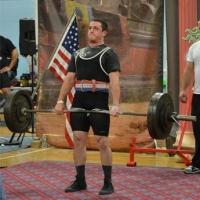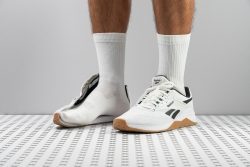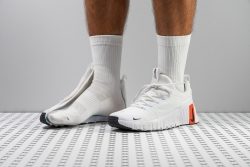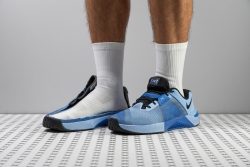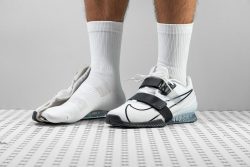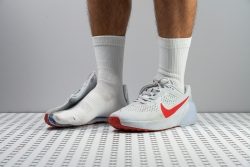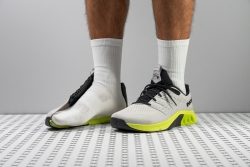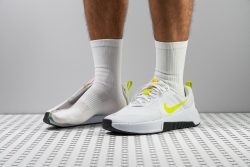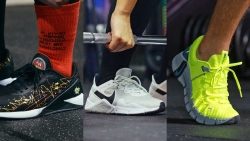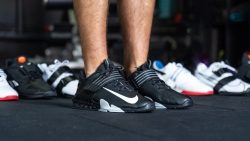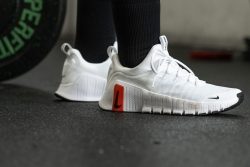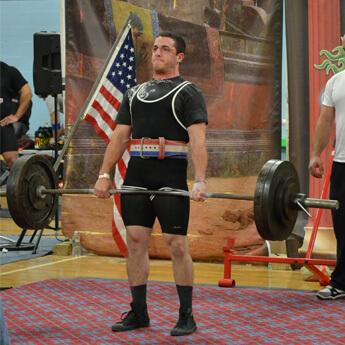7 Best Gym Shoes For Men in 2025
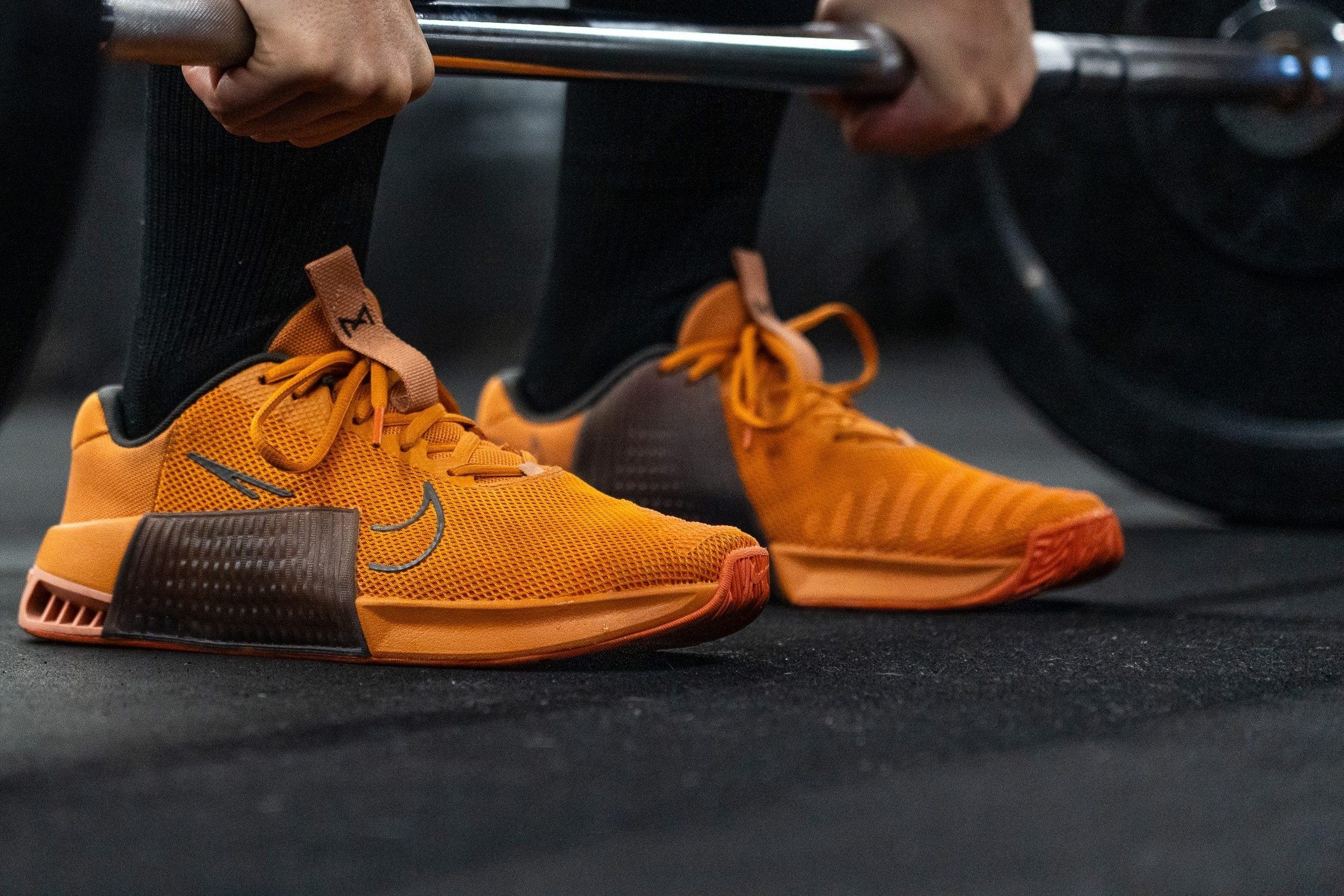
We buy shoes ourselves. We earn commissions when you buy through us, at no extra cost. Why trust us
Hitting the gym has become part of many guys’ routines in the past years. As a result, every major brand started producing different types of fitness gear, gym shoes included.
Given the number of options available, it’s easy to get overwhelmed, especially if you are a first-time shopper. We want to make things easier for you, so we took it upon ourselves to test all men’s gym shoes that we get our hands on - dozens of them - so that we can pick the best ones for your needs.
How we test gym shoes for men
To ensure the objectivity of our review and assessment, we do the following:
- We buy shoes using our own money. No free pairs or sponsorships.
- We hit the gym with every tested gym shoe and we maximize their use by doing all sorts of workouts, including cardio, lifting, and others.
- We dissect, test, and measure each trainer in our lab using calipers, durometers, Dremels, a smoke-pumping machine, a liquid gel, and many more tools. In the end, you get a clear and objective picture of each gym shoe's energy return, shock absorption, stability, durability, flexibility, and many other characteristics.
Best gym shoes overall
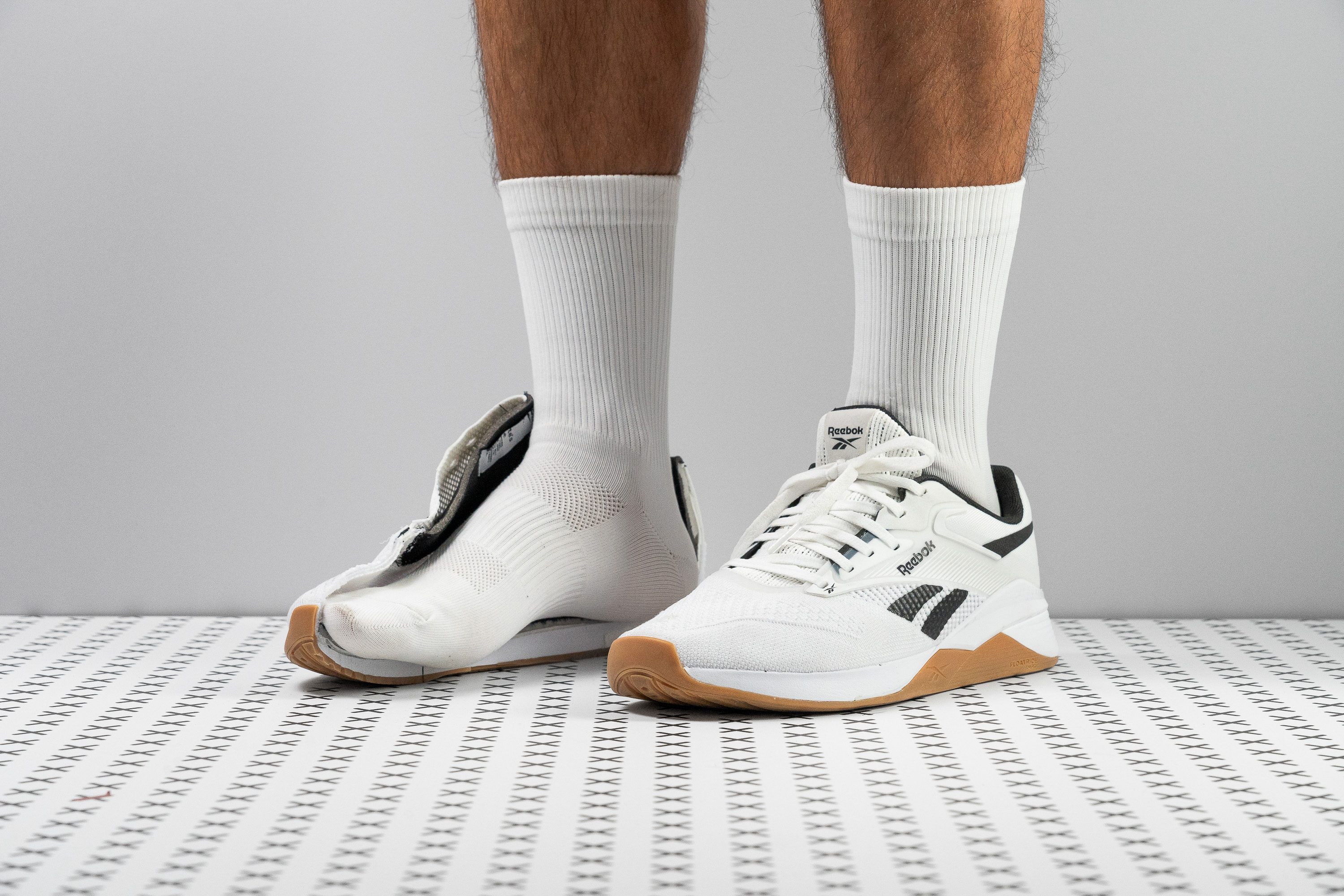













































What makes it the best?
The Reebok Nano X4 has a steady and sturdy structure without compromising agility, allowing us to train with full intensity without any worries. From lifts to cardio sessions, we felt fully confident since it excelled in our stability and durability lab tests. With its versatility and ease of use, we found it to be the best gym shoe for men.
Performing explosive movements and static exercises was a breeze because of its Lift and Run Chassis that prevents excessive lateral movements. Twisting the shoe took much effort, so we awarded it a 4/5 torsional rigidity score, effectively stabilizing our feet.
Our lab tests show it takes a lot to break this shoe, perfect for men who prioritize durability. From rope climbs and careless on-and-offs to ground friction, Nano X4 could take it all! It earned a remarkable 4/5 durability score in the toebox and heel, while underfoot, it showed minimal 0.5 mm damage vs. the 1.1 mm average.
Despite its tough nature, it doesn’t sacrifice ease of movement. Our feet enjoyed its light feel, which our scales confirmed with an 11.7 oz (322g) reading. For all the support it offers, it’s only slightly heavier than the 10.8 oz (305g) average. Plus, its lightness is enhanced with its high energy return, scoring 61.0% in the heel and 58.4% in the forefoot.
However, men who do hardcore lifting and running should invest in a more specific training shoe. Nano X4 is an all-rounder but is a master of none.
Pros
- Fantastic wear resistance
- Great balance of cushioning and stability
- Feels grounded and supportive
- Secure foot lockdown
- A fully-gusseted tongue (finally)
- Nice breathability
- Lighter than the X3
- Great grip on gym floors
Cons
- Not for heavy lifting
- Not for wide feet
Best gym shoes for HIIT






















































What makes it the best?
A solid HIIT shoe requires stability, ease of movement, and cushioning—the Nike Free Metcon 6 ticks all these boxes during our heart-pumping sessions. Our lab confirms it’s the most flexible shoe in the market so far, but what’s amazing is that we still felt surefooted, which is why it undoubtedly leads the HIIT category among men’s gym shoes.
The Free Metcon 6 cleverly integrates support into this flexible shoe, as we discovered a firmer 27.8 HA cushion under the heel after slicing the midsole in half. This is perfect for men seeking stability while feeling agile. Besides this, it has a spacious base, which boosts ground connectedness and steadiness. Our caliper shows a massive 113.9/94.4 mm midsole vs. the 110.6/87.3 mm average.
Even with its wide midsole, it never felt too bulky. On the contrary, Free Metcon 6 feels barely there. Our scales confirm it’s only 9.7 oz (274g), 11.3% lighter than average. Its exceptional flexibility adds to its weightless feel too. While the average trainer needs 11.1N to bend to 30 degrees, this shoe only 9.0N.
Whenever we performed repetitive jumps, we felt comfortable and had enough cushion beneath our feet. Our durometer confirms it’s 41.1% softer than average.
However, its sock-like fit is quite a nuisance when putting the shoe on, especially for men with voluminous feet.
Pros
- Fantastic breathability
- Very light on foot (lighter than average too)
- Abundant cushioning for HIIT
- Most flexible cross-trainer ever
- Excellent stability for moderate weightlifting
- Sock-like fit in a bootie upper
- Accommodating toebox (for medium feet)
- Great grip on gym surfaces
Cons
- NOT for rope climbs (lacks protection)
- Can be hard to put on (narrow opening)
Best gym shoes for Crossfit
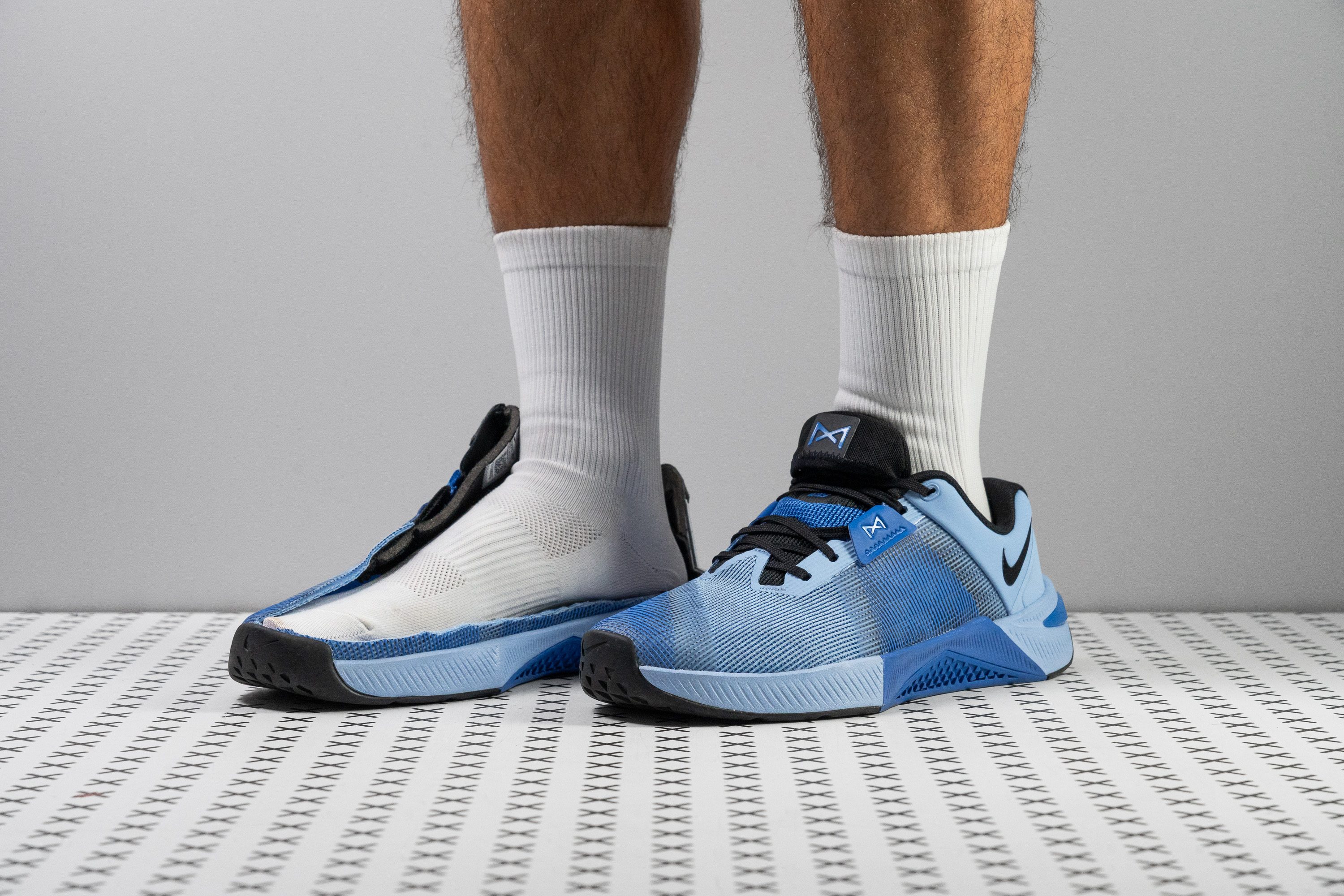














































What makes it the best?
The Nike Metcon series makes waves in the training scene again as the v10 emerges as our ultimate CrossFit men’s gym shoe. It offered a sturdy base, impressive grip, and adaptive flexibility that helped us perform a wide range of WOD exercises with all-out effort. Our lab assessments confirm its low profile boosts ground connection and control while ensuring we can still perform fluid movements with ease.
Metcon 10 offers unwavering support, particularly for lifting, and is a great training partner for men who want to increase weights over time. It features a below-average 22.8/16.2 mm stack that includes a sturdy Hyperlift heel insert so it doesn’t compress under heavy loads.
The wide midsole and reliable traction instill confidence as we perform various movements. Our caliper shows an above-average 115.2/90.8 mm base, offering extra ground coverage for enhanced sensitivity. Even on slippery floors, the outsole offered the traction we needed for lunges, burpees, and lifts, proven by its solid 0.38 rating in our traction test.
This trainer proves stable shoes don’t have to be rigid. It took minimal effort to perform foot-bending workouts such as planks. Our bend test confirms it's 13.2% more flexible than average, an astounding result for the stability it offers.
However, men seeking a well-ventilated experience will be disappointed with Metcon 10. Scoring only 2/5 in our smoke test, we recommend finding a more breathable shoe for heated and sweat-filled sessions.
Pros
- More versatile Metcon overall
- One of the lightest Metcons ever!
- ReactX adds shock absorption and energy return
- Increased forefoot flexibility
- Still amazingly stable for weightlifting
- Fantastic upper durability (even for rope climbs)
- Great grip on gym floors
- Highly secure foot lockdown
- Accommodating fit and toebox
- Handy Lace Tuck
Cons
- Outsole could be more durable
- Upper lacks breathability
Best gym shoes for weightlifting
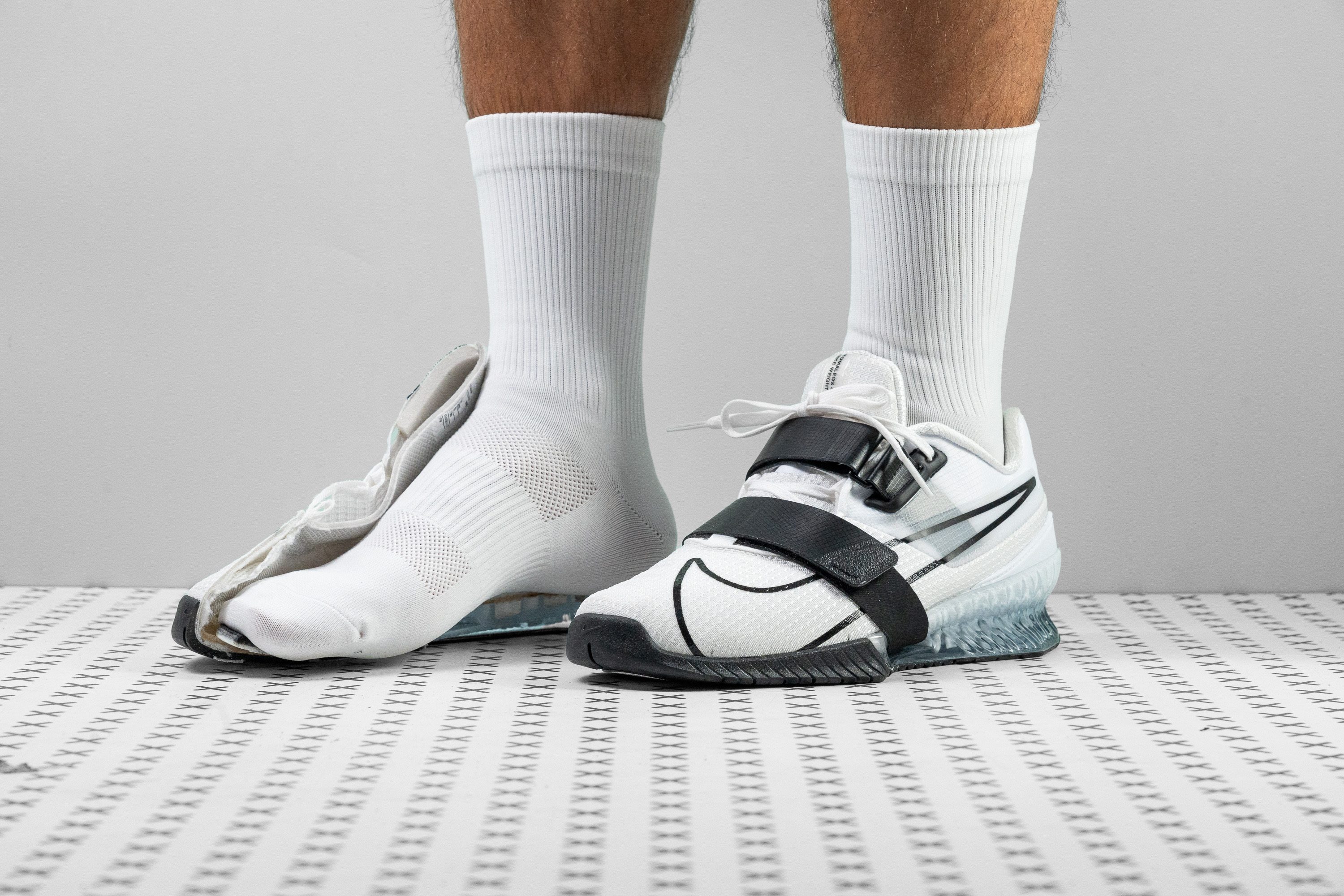





























What makes it the best?
The strong foothold we experienced in the Nike Romaleos 4 is incomparable. It’s so good and effective that it’s highly suitable for professional and serious lifters. We felt so secure with its firm embrace and its unwavering support underfoot. Our lab test confirms no compressions whatsoever under heavy loads, making it our ultimate weightlifting gym shoe for men.
The rear part of our foot is locked in thanks to the extended TPU walls and unforgiving heel counter that received a 5/5 rigidity rating in our assessment. From the top, two Velcro straps facing opposite directions keep us centered and balanced, enhancing stability that’s crucial for lifting.
The midsole is the toughest lifter we’ve measured so far with a 97.0 HA durometer reading, ensuring men can carry the heaviest of loads without the platform collapsing. It also has a spacious 111.5/91.3 mm midsole to allow us to find our footing.
Despite its brute façade, it feels comfortable thanks to the padded upper that wraps around our foot. However, it leaves minimal room for ventilation. We cannot recommend this trainer to men who don’t like feeling stuffy and sweaty inside the shoe.
Pros
- Phenomenal stability
- Sturdy platform and sole
- Better lockdown with two straps
- Comfortable for a lifting shoe
- True to size
- Efficient traction
- Appealing looks
Cons
- Upper lacks durability
- Not for narrow ankles
- Not breathable
Best gym shoes for cardio workouts
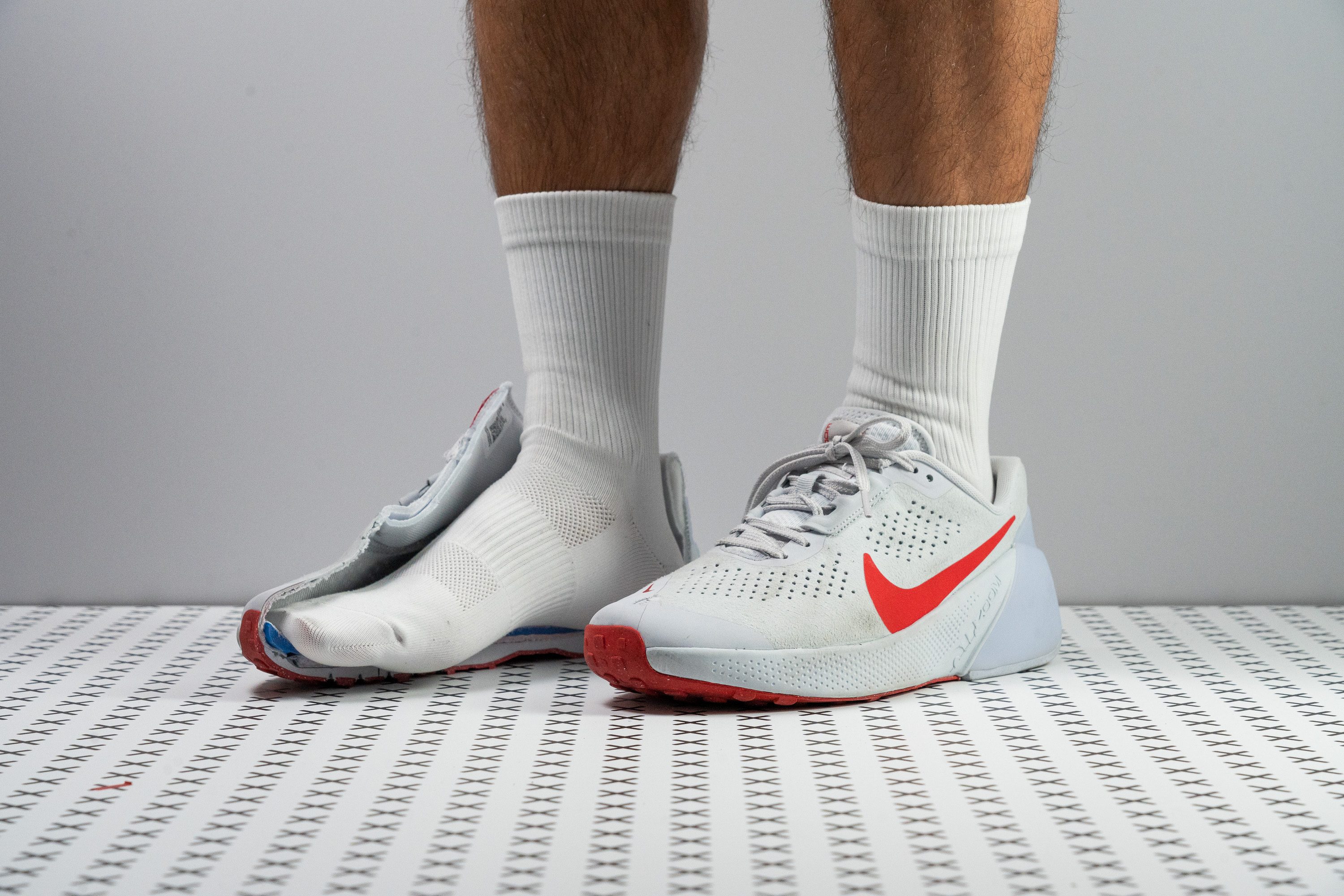











































What makes it the best?
The Nike Air Zoom TR 1 has a comfortable and energetic midsole that ensures we can perform repetitive jumps and explosive workouts enjoyably and with zero pain. We indulged in its soft feel, which our lab test confirmed, while its confidence-inspiring traction fueled us to perform at full force. Based on our experience and lab results, the Air Zoom TR 1 is our top cardio gym shoe for men.
We performed intense high-impact workouts repetitively and found ourselves wanting to do more. The cushion protected our joints as we performed burpees, jump ropes, and high knees. Pushing our durometer against the foam, it emerged 26.3% softer than average. Besides its plush sensation, the Air Zoom unit consistently offered responsiveness that made the exercises feel effortless.
We also had no issues with stability, which makes it suitable for men who want to complete workouts worry-free. We felt surefooted the whole time and the super grippy outsole made us feel even more secure. It gave us control over slippery gym floors, allowing us to do various footwork with ease and speed. Our durometer shows the rubber is 8.9% softer than average, which usually translates to better traction based on our lab observations.
However, men who sweat a lot and need ventilation will struggle to finish heated workouts in this airtight shoe. If breathability is a must, we can’t recommend this trainer.
Pros
- Dependable bite on gym floors
- Pretty durable toebox
- Good impact protection
- Nice lateral stability
- Secure heel hold
- Smooth heel-to-toe transitions
- OK for occasional outdoor use
Cons
- Not breathable at all
- Not for heavy lifting
Men's gym shoes with the best traction
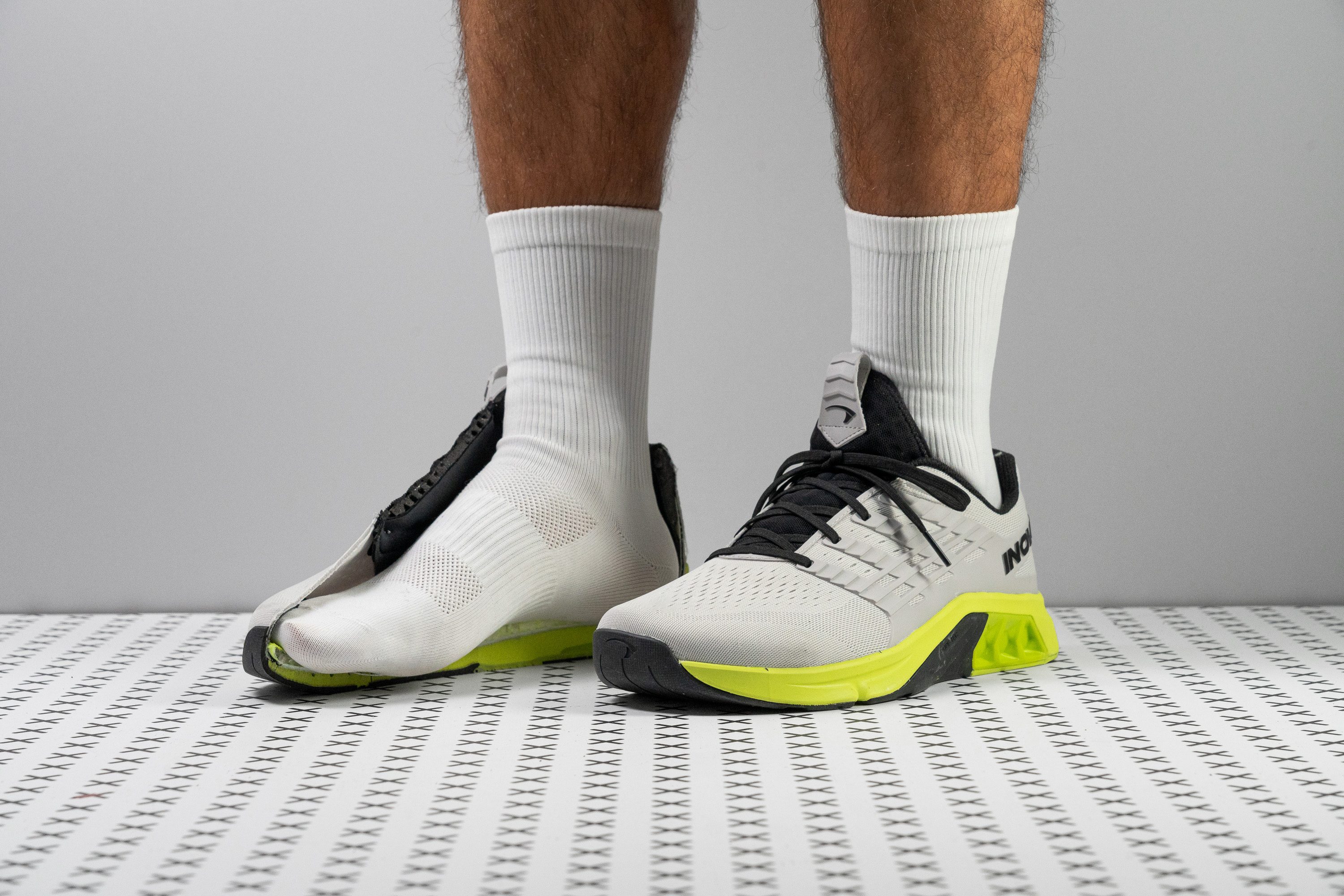























































What makes it the best?
We tested the Inov8 F-Lite Max in our gym sessions and further in the lab and noted its steadfast support and enormous toebox. Yet what makes it truly stand out among men’s gym shoes is the unmatched traction it delivers, giving us next-level confidence in our movements.
From jumping on boxes to pushing off shiny gym floors, the F-Lite Max gives us stopping power like no other. We tested it under wet conditions in the lab, and recorded a high friction coefficient of 0.53, making it a mind-blowing 55.9% gripper than average! What’s even more awesome is that this same compound reaches the sides to form the Rope-Tec and deliver that same grip when rope climbing.
The midsole feels structured and supportive, making it a strong contender for lifting. It features a massive TPU heel stabilizer that doesn’t compress under heavy loads, plus the midfoot includes the Met-Cradle cage to keep us centered. Its high 4/5 torsional rigidity validates the effects of these features.
Using our gel mold, we wanted to measure the very accommodating toebox we enjoyed. True enough, it’s super wide at 81.0 mm, 10.8% above the average, and can welcome men with very wide feet. However, it failed to impress in our Dremel test. With the lowest 1/5 toebox durability score, be careful not to slash and burn this pair during rope climbs.
Pros
- Fantastic stability for lifting and Crossfit
- Great for heavier lifting (stiff TPU heel)
- Awesome for wide feet
- Good forefoot flexiblity
- Highly breathable toebox
- Solid outsole durability
- Protection for rope climbs
- The stickiest outsole rubber
Cons
- Heavier than average
- Clunky and firm for HIIT/cardio
- Frail upper fabric
Men's gym shoes with the best shock absorption
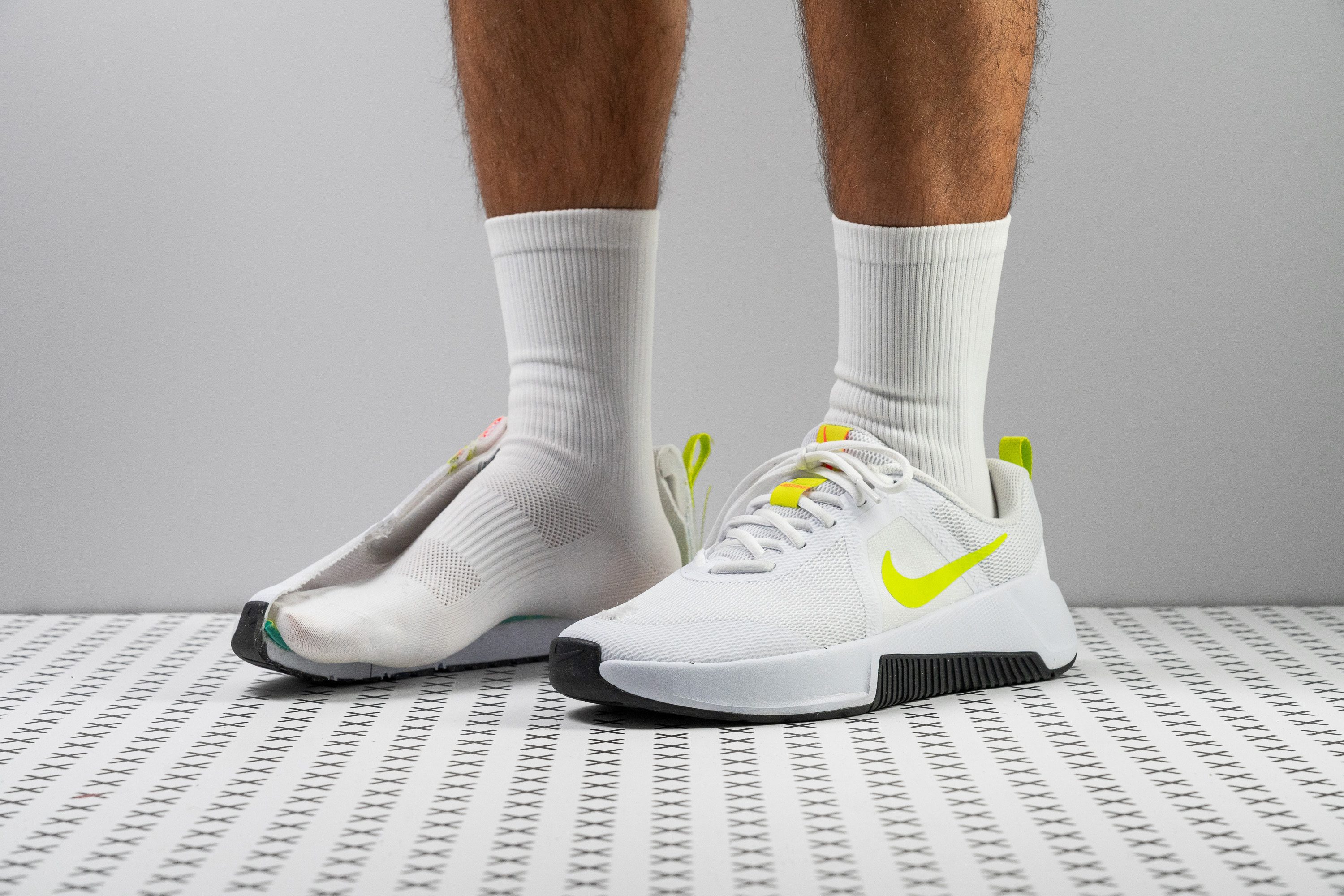

















































What makes it the best?
Maximum comfort for a minimal cost, our lab shows the Nike MC Trainer 3 offers exceptional cushioning, a refreshing aura, and impressive versatility for only $80. Our feet attest to all its delightful features as we experienced free movement and gentle landings while training with this shoe. Overall, its superior shock absorption makes it stand out in the men’s gym shoes category.
Our muscles thanked us for wearing this trainer during repetitive jumps and warm-up runs. It’s well-cushioned and reduces leg stress. Our caliper confirms an above-average 30.6/21.8 mm stack, while our shock absorption test reveals high scores of 97 SA (heel) and 83 SA (forefoot). Compared to the average, it offers 15.5% and 30.0% better joint protection, respectively.
As a well-ventilated space, comfort is further intensified during heated sessions. We pumped smoke into the shoe, and it flowed out seamlessly, earning it a perfect 5/5 breathability score. It feels great not to have our body heat and sweat trapped inside the shoe, making it highly suitable for men who need unobstructed airflow.
Easy on the pocket and foot, our scales reveal MC Trainer 3 is only 10.4 oz (296g). Being lighter than average, it feels easier to move in the shoe.
However, we find that it lacks traction for more controlled footwork, which may be a concern during dynamic and multi-directional movements. Men who prioritize a grippy trainer should skip this pair.
Pros
- Fantastic value for money
- Highly breathable
- Doesn't drag the foot down
- Better cushioned than v2
- Heel bevel is better for running and walking
- Decent stability for moderate workouts
- Good flexibility for lunges and planks
- Accommodating toebox
- Comfortable padded interiors
Cons
- Not for flat and wide feet (narrow midfoot)
- Upper lacks wear resistance
- Weak outsole grip
Why men should invest in a proper gym shoe
The gym industry, which hardly existed 60 years ago, has evolved into a multi-billion dollar business. One outgrowth of this is that gymgoers are faced with a lot of so-called essential gym wear to enable them to step onto the gym floor safely and confidently. Many of them, like compression clothing and weightlifting gloves, are not essential at all.
Gym shoes, however, are!
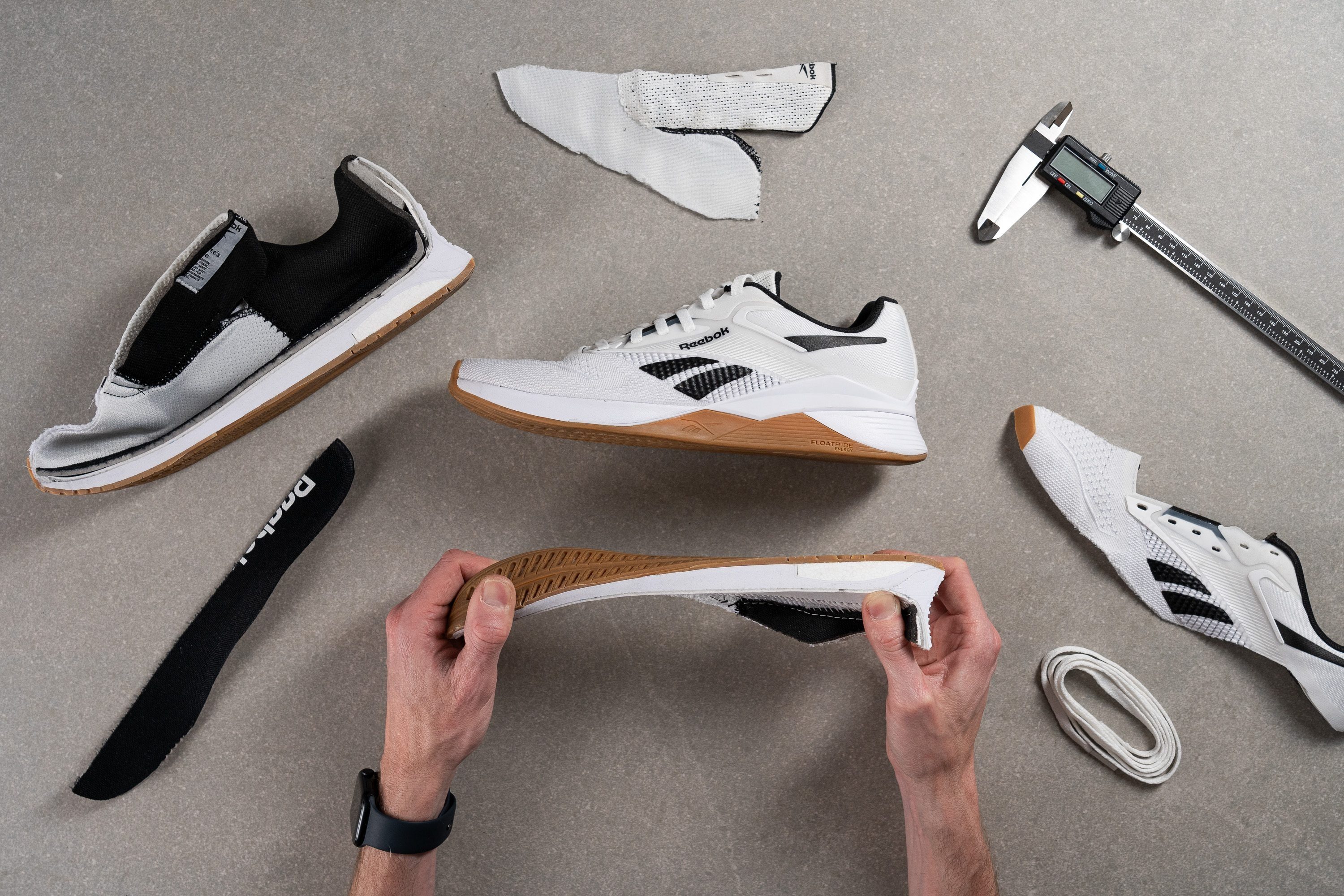
If you’re a guy who takes his training seriously, you need to get serious about your footwear. Too many people become frustrated with their workouts (or even get injured) just because they turned up wearing casual sneakers, running shoes, or, believe it or not, flip-flops to the gym.
As this study confirms, training in shoes specifically designed for aerobics or cross-training can prevent some lower limb injuries.
A pair of running shoes won’t cut it
As comfortable as you might feel in a favorite pair of running shoes, there are quite a few science-backed reasons why they don’t make the best companion at the gym:
-
Lack of multi-directional support: Designed with forward motion in mind, running shoes provide little-to-no lateral support during explosive side-to-side movements. This puts your feet and ankles at risk of rolling over the edge of the shoe.
Lateral support in a cross-trainer
Lateral support in a running shoe
-
Awful stability for weightlifting: Cushioned running shoes easily compress under heavy loads resulting in loss of stability, force generation, and blunt proprioception of the feet.
-
Curved soles: Heel bevels and toe rockers of running shoes prevent your feet from sitting flat on the ground. This interferes with the biomechanics your body uses to balance and stabilize itself during jumps, squats, and other exercises.
The bottom line is that investing in a dedicated men’s gym shoe is not a luxury—it is an essential requirement for any guy who trains regularly at the gym.
|
We understand that a proper gym shoe is a serious investment with an average retail price of $123. But if you go to our catalog page of men’s gym shoes and sort by discount, you will be amazed at some of the offers! Even the most expensive trainers can be found for 70% less. You might as well consider cheap gym shoes that are offered for as low as $50. |
Now let’s help you get the right pair of trainers.
Types of men’s gym shoes
‘Gym shoes’ is a broad term which includes the following types of training/workout shoes:
- Cross-training shoes (also Crossfit and HIIT shoes): versatile enough for both lifting and plyometrics
- Weightlifting shoes: sturdy shoes with high heel wedges meant for heavy lifting
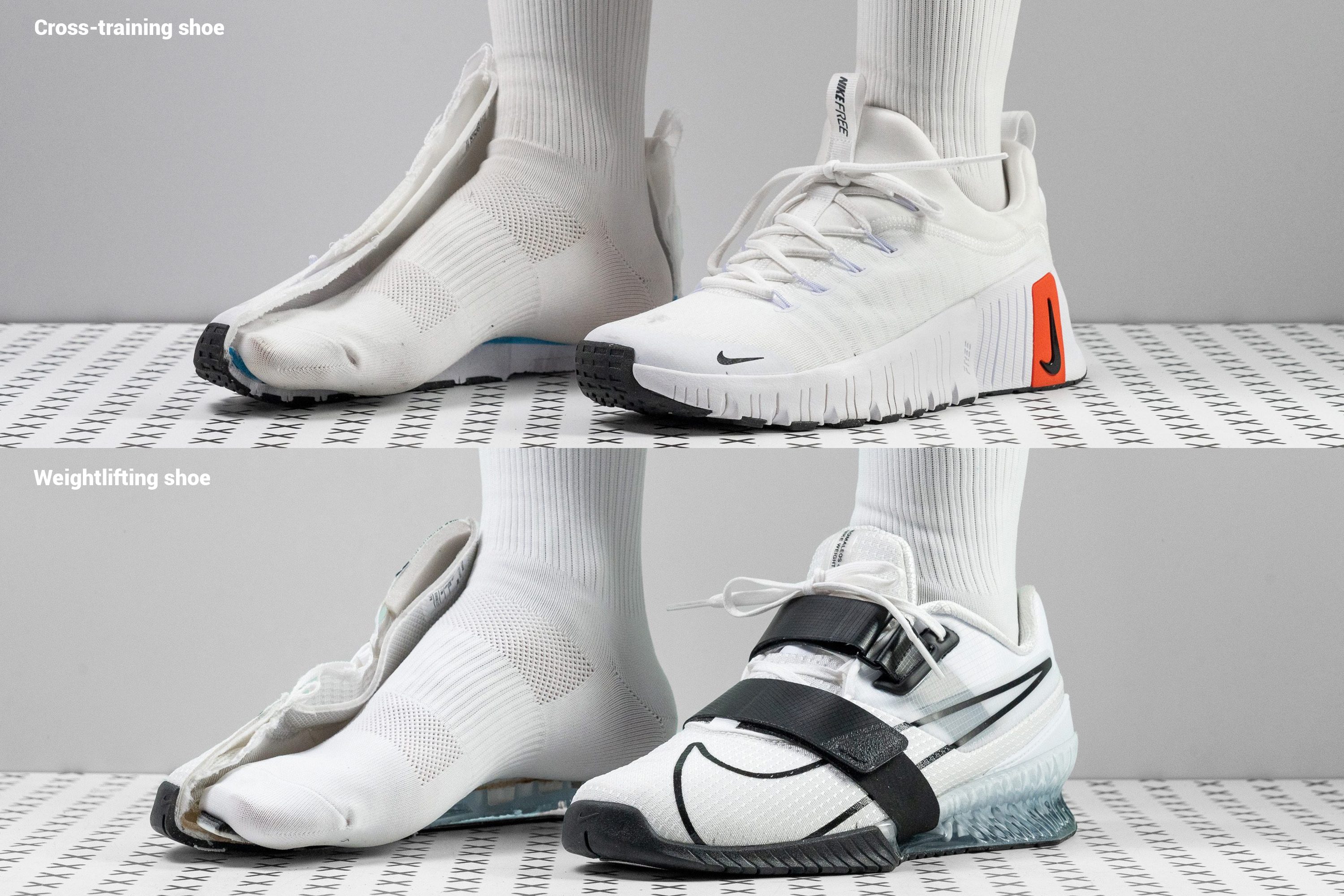
Do you need a different pair of gym shoes for different kinds of workouts?
Most training shoes for men are versatile enough to handle a little bit of everything at the gym but some are better geared toward specific exercises, i.e. runs and jumps or heavy lifting.
Thus, knowing what your regular training regimen looks like helps you find the best matching gym shoe and avoid buying multiple pairs.
Even though there are a few scenarios in which you may need more than one pair after all:
- if you run more than 1-2 miles on a treadmill regularly (get a proper running shoe)
- if you lift heavy and want to work on a proper squat form, have ankle mobility issues, or plan to compete (get a proper lifting shoe)
- if you want to incorporate more natural foot movement, strengthen your foot muscles, and improve ankle flexibility (get a minimalist training shoe)
1. Versatile cross-training shoes for men
A cross-training shoe will get you through a WOD or anything your gym coach throws at you. From plyometrics and agility training to lifting and stretching, these shoes provide a perfect balance of stability, support, and cushioning to tackle it all.
But because it is such a broad category, it comes with a spectrum. To help you narrow down your choices, all cross-trainers can be roughly divided into three categories:
- cushioned shoes for high-impact cardio
- stable shoes for strength training/lifting
- minimalist shoes for foot strengthening
Cushioned cross-trainers for high-impact cardio
If you primarily focus on cardio or aerobic/anaerobic conditioning, you will benefit from a more cushioned trainer to perform lots of jumping, short runs, and agility training.
Here are the primary characteristics of these shoes:
- good shock absorption/impact protection (at least 90 SA in the heel)
- lighter than average or average weight (and no bulky heels to drag the foot down)
These features also make these trainers comfortable enough for day-to-day wear outside the gym.
Stable cross-trainers for strength training/lifting
Guys getting serious about Crossfit and weightlifting must consider more stable cross-trainers to match their fitness needs. These shoes are designed with strength training in mind and are better geared for squats, deadlifts, cleans, jerks, etc. But unlike wedged lifting shoes, these trainers are still ready to tackle the plyometric bits of your WODs.
Here is what you can expect from these cross-trainers:
- high level of torsional rigidity keeps the foot stable
- stiff and supportive heel counters prevent wobbling
- wide and flat midsole creates a stable platform
We twist, push, and squeeze each training shoe in our manual tests to determine their rigidity on a 1-5 scale (5 being the stiffest). After that, we grab a caliper to measure the widest areas of its midsole both in the forefoot and in the heel.
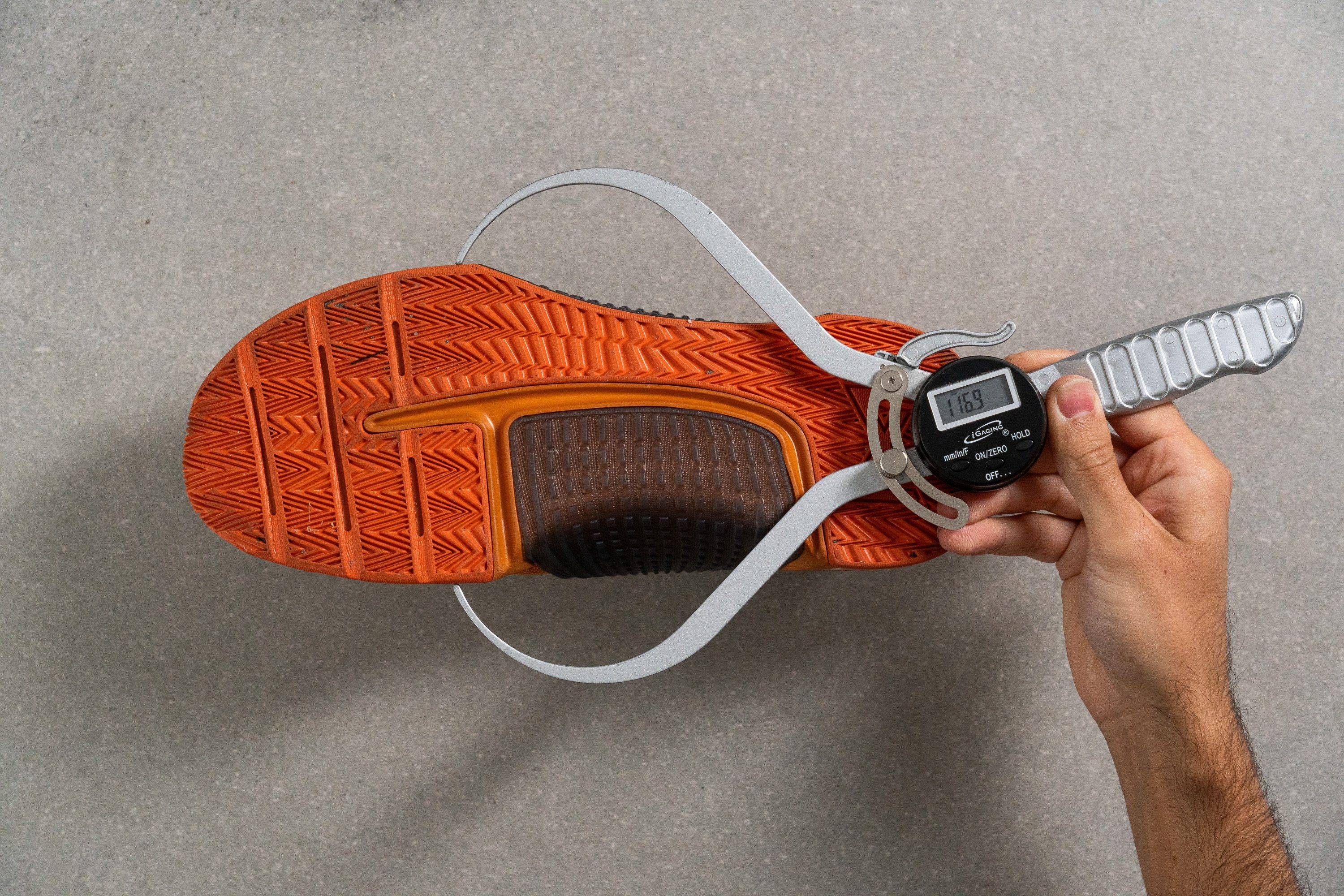
That way, you know exactly which cross-trainers can make you feel most planted and surefooted:
Minimalist cross-trainers for foot strengthening
If you are a beginner gym goer, we don’t recommend getting minimalist shoes straight away. Your feet and body are used to receiving support and cushioning from shoes so jumping into a barefoot-style shoe unprepared can really mess up your biomechanics.
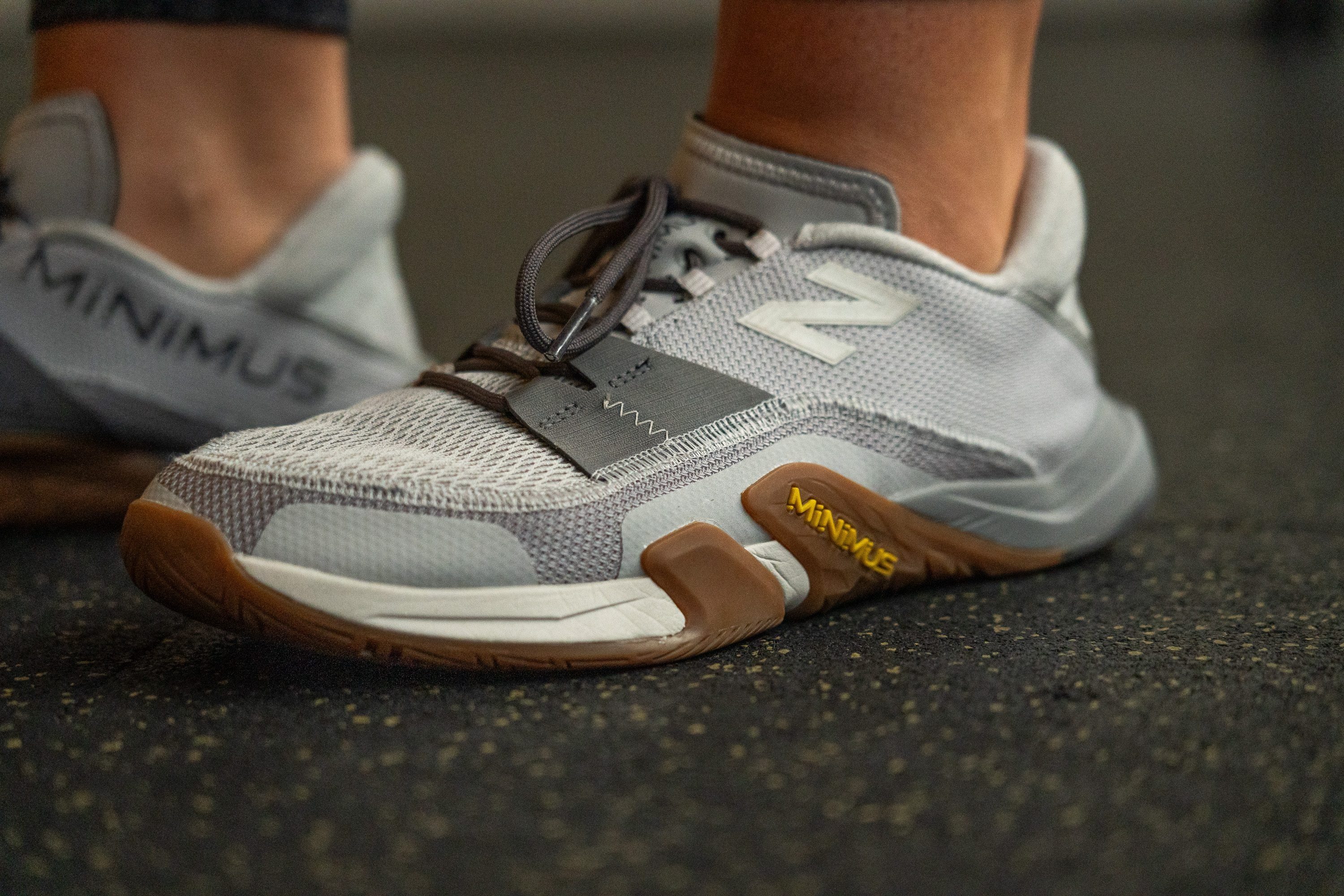
But if you take it slow and are mindful of the process, you can reap a lot of benefits from occasionally training in a minimalist shoe:
- better engagement of the muscles, tendons, and ligaments in your feet
- better proprioception (awareness of position and movement in space) improves coordination, posture, and balance
- more natural biomechanics and body alignment (better posture)
Here is what sets a minimalist shoe apart from a typical gym shoe:
- ultra-thin sole (10-15 mm)
- highly flexible, bends along with the foot
- lightweight, barely-there feel
2. Weightlifting shoes for men
This footwear category is built exclusively for lifting weights.
A lifting shoe is easy to tell apart from other trainers thanks to its stout incompressible wedge under the heel and a pancake-flat sole. This setup is most optimal for Olympic weightlifting movements like squats.
Here is a closer look at the pros and cons of this gym shoe type.
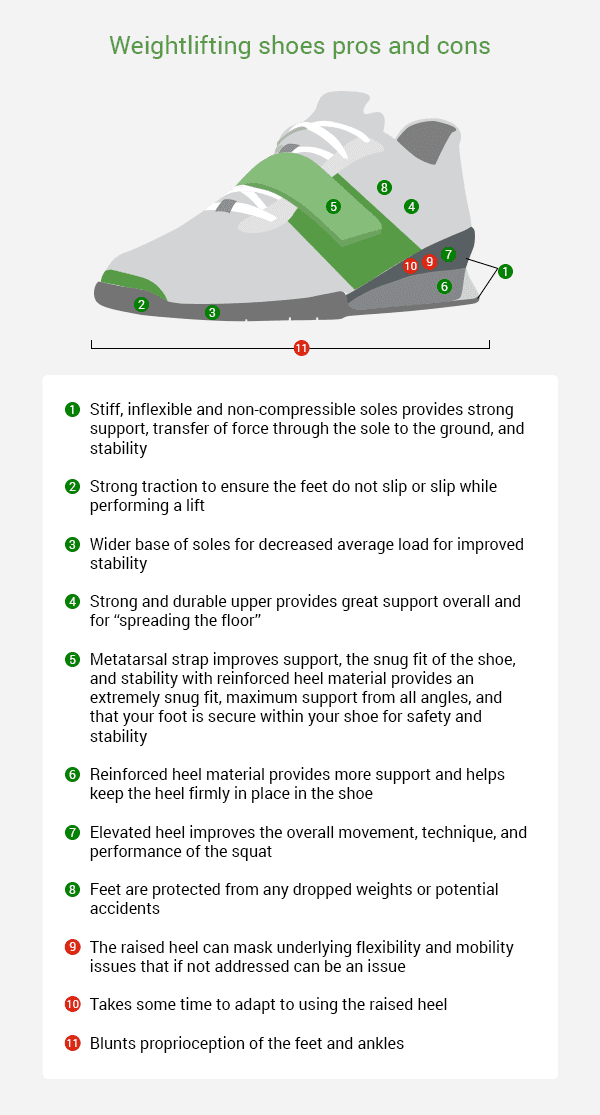
But even this niche shoe category has some variability, and the most important variable is the heel-to-toe drop (aka heel elevation). Ranging from 15 mm (0.6 in) to 21 mm (0.8 in), every heel height has its target audience:
- 15-16 mm: appropriate for beginners as the heel elevation is not so steep and the shoe can still be used for some exercises outside of lifting
- 20-21 mm: best for seasoned athletes who perform high-skill Olympic lifts and go deeper into squats
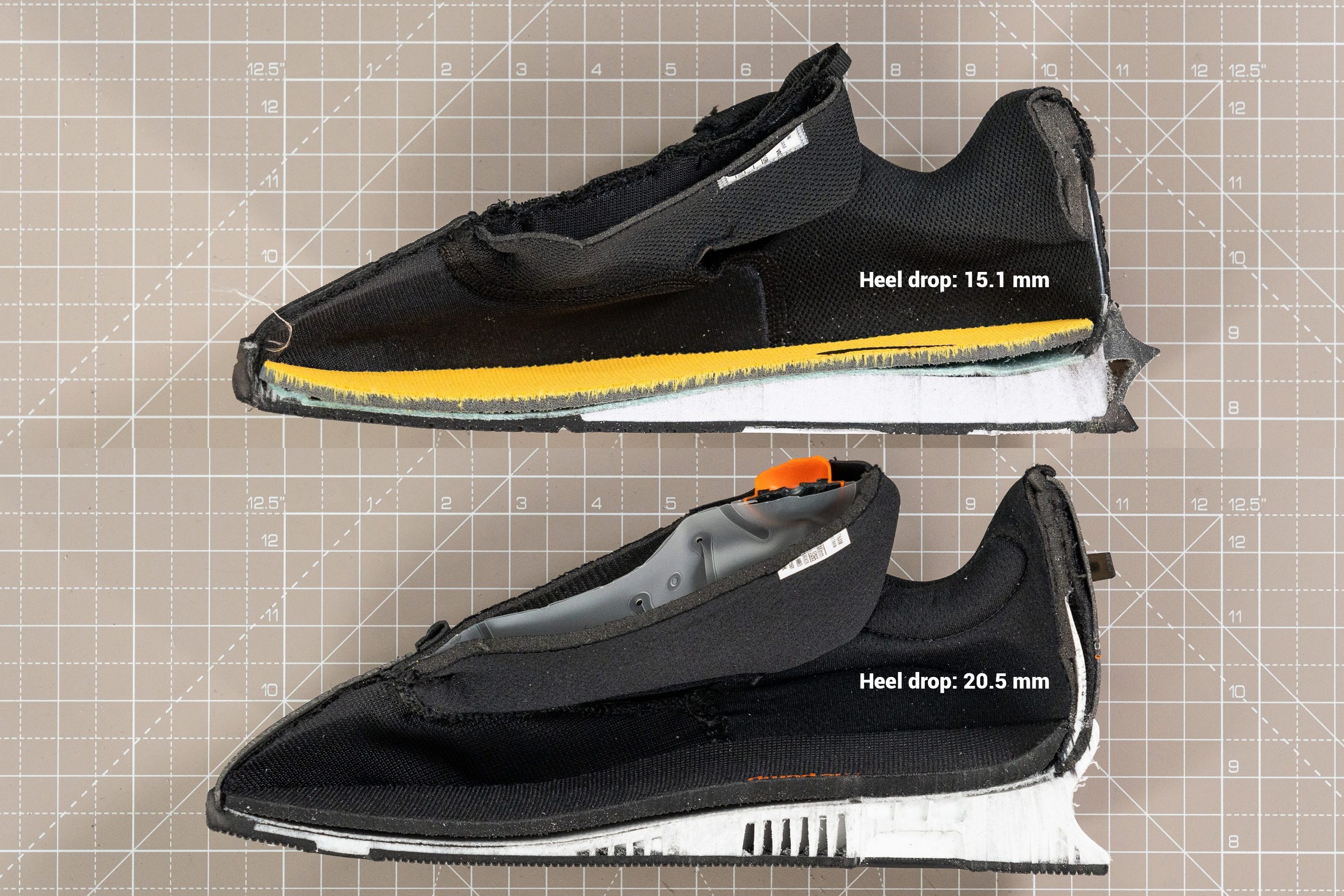
Zero-drop (0 mm) shoes like Adidas The Total also become more common in response to the demand for flat and grounded platforms for deadlifting.
Lifting weight in front of your body requires different biomechanics than squats (when the weight is on your shoulders) and some athletes preferred wearing Converse Chucks for deadlifts in the past as these flat kicks help to achieve a more neutral body position, maintain a more natural back angle and reduce the risk of rounding your spine.
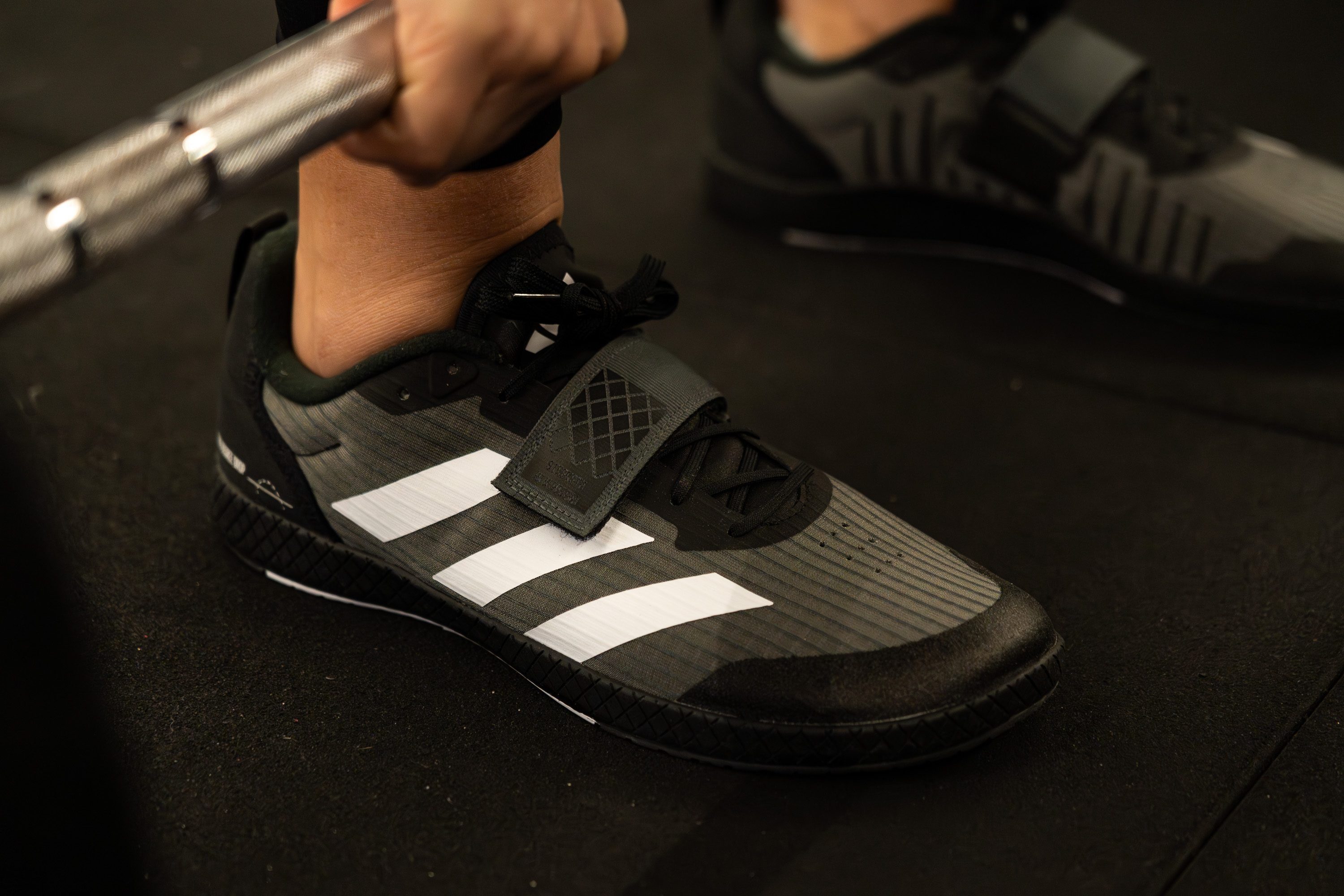
Finding the right size and fit in men’s gym shoes
Getting the right fit is essential when choosing men's gym shoes for comfort and performance. That’s why you should consider both size and width in your future pair.
|
Size |
The shoe should be long enough to leave room between your longest toe and the end of the shoe. There must be sufficient space for the toes to wiggle and avoid rubbing against the shoe's front. |
If you are buying a new shoe online, we recommend measuring your foot length and checking with the corresponding brand size chart. If a retailer offers free shipping, get 2-3 pairs in different sizes and send the ones that didn't fit back.
|
Width |
The shoe should be wide enough to fit the natural width of the foot, while still making it feel supported. The toebox should be roomy enough to let the toes splay freely without discomfort or pinching. |
Training shoes typically have wider toeboxes than running shoes or sneakers. That’s because they are meant to accommodate a natural toe splay which occurs during exercise when you try to find balance and stabilize yourself.
TIP: It is best to try on gym shoes later in the day when the feet are naturally a little larger. Be sure to wear the same kind of socks that are planning to use with the new shoes.

To help you find the right fitting shoe, we create a gel mold of every men's gym shoe in our lab. We then measure its dimensions precisely with a caliper. The photo above shows how different two shoes can be even in the same size (men's US 9).
Consider durability of your gym shoes
A quality pair of gym shoes should be able to resist both normal wear and tear and the unique requirements of your training regimen.
If you don’t want to replace a gym shoe every month, it’s better to check for the following longevity signs in its upper and sole:
Upper:
- wear-resistant upper fabric
- wear-resistant inner lining (especially in the heel area)
- protective rubber or TPU elements (espeically if you do rope climbs)
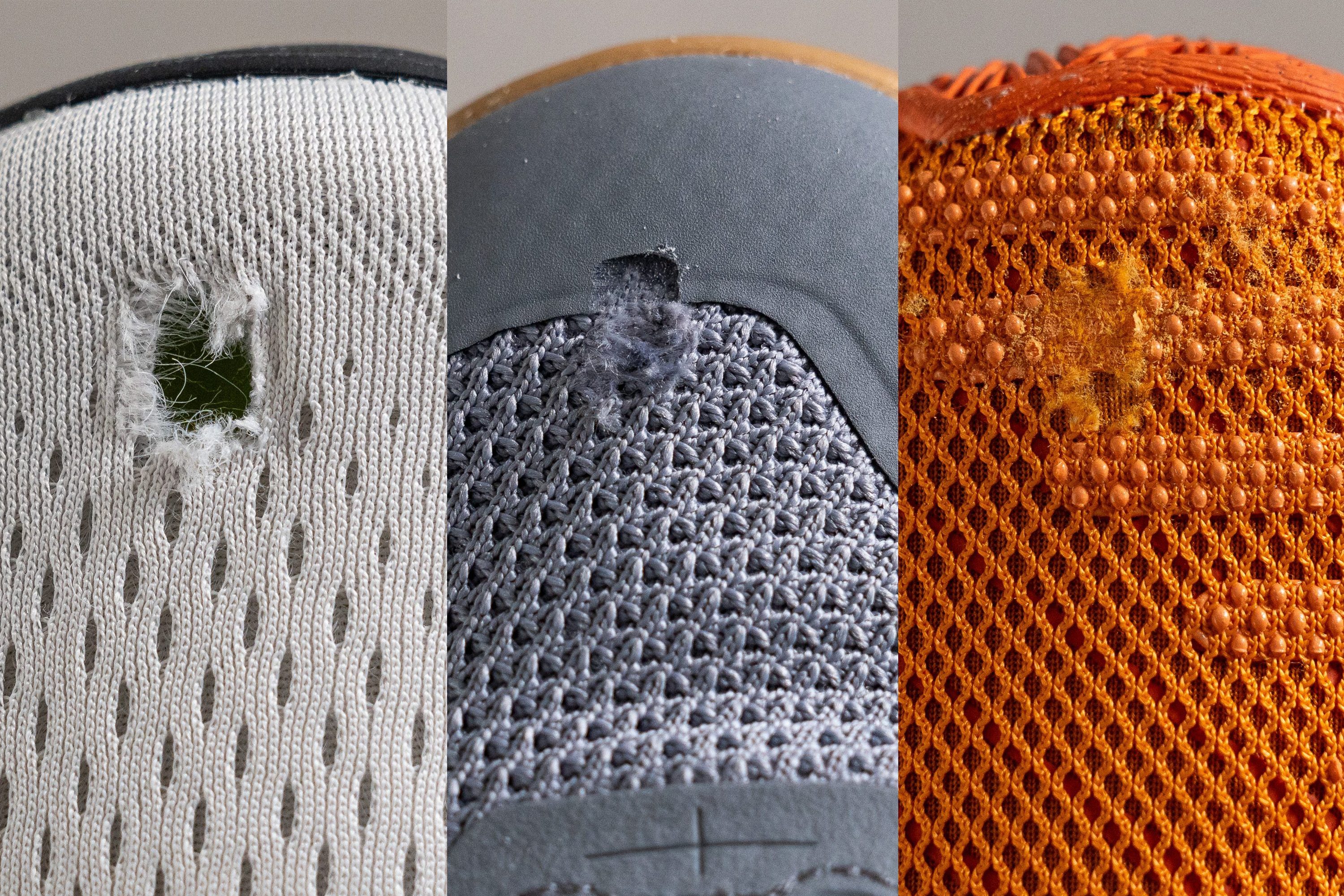
Sole:
- Thick full-length rubber outsole
- Abraison-resistant rubber (espeically if you occasionally train on concrete)
In our lab, we perform several demanding durability tests on various shoe parts using sandpaper and a Dremel. We keep the Dremel speed, pressure, and exposure time consistent across all tested gym shoes for comparable results.
Here is the overview of most durable men’s gym shoes based on our findings:
Don’t forget to check breathability
Who doesn’t love a nice and sweaty workout?
Someone who’s wearing stuffy gym shoes! That's why it is important to choose trainers with well-ventilated mesh uppers which allow air to circulate, dissipating the heat and keeping your feet cool and dry.
It’s tricky to tell how breathable a gym shoe is by simply looking at its photos online. That’s why we equipped our lab with a smoke-pumping machine, a LED light, and a microscope to test the ventilation capacity of each shoe and demonstrate it to you.
Some brands go as far as perforating the sole to increase airflow
The overview below features the most breathable gym shoes for men on a 1-5 scale (5 stands for most breathable):
